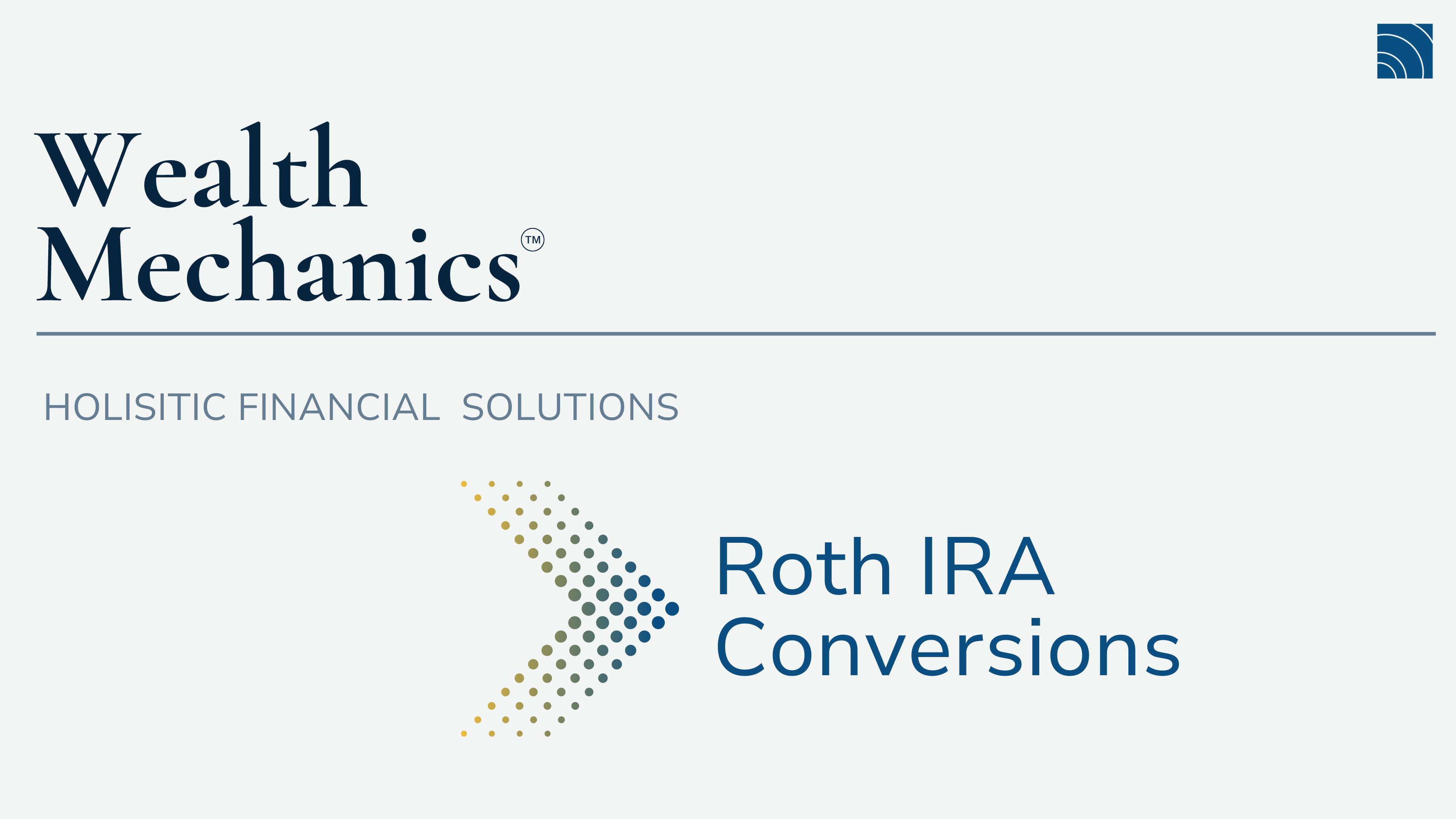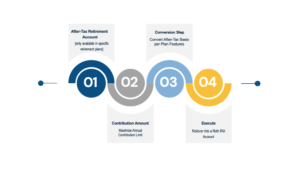
Optimizing Tax-Efficient Wealth: Mastering the Roth IRA Conversion
A Roth IRA conversion is a powerful financial maneuver where retirement assets from tax-deferred accounts—like a traditional IRA, Simplified Employee Pension (SEP), SIMPLE IRA, or a 401(k)—transfer into a Roth IRA. This conversion may cause tax liabilities, however, the long-term benefits of tax-exempt gains and tax-free withdrawals make it a compelling choice for some investors.
Roth IRA Conversion Types
- Standard Roth IRA Conversion: A standard Roth IRA conversion transfers assets from tax-deferred accounts (traditional IRA, SEP IRA, SIMPLE IRA, or 401(k)) into a Roth IRA. You will pay taxes on the converted amount now, but the funds grow tax-free and can be withdrawn tax-free in retirement.
- Backdoor Roth IRA Conversion: For high-income earners exceeding Roth IRA income limits, a backdoor Roth conversion allows you to contribute to a traditional IRA and then convert those funds to a Roth IRA, bypassing the income restrictions.
- Mega Backdoor Roth IRA Conversion: The mega backdoor Roth conversion enables high savers to make after-tax contributions to a 401(k) and then convert those contributions to a Roth 401(k) or Roth IRA. The mega-backdoor Roth happens when an employee maximizes their after-tax deferral amount and then converts those dollars to Roth within their plan to add to their annual deferrals (or rolls them out while still participating). When the conversion is done as soon as administratively possible, the employee effectively excludes the growth of the after-tax dollars from taxation as well.
Wealth Mechanics™ Flow Chart
STANDARD CONVERSION
CLIENT TAX BRACKET: ALL

BACKDOOR CONVERSION
CLIENT TAX BRACKET: HIGH-INCOME EARNERS

MEGA BACKDOOR CONVERSION
CLIENT TAX BRACKET: HIGH SAVERS + ALLOWED PARTICIPANTS

How a Roth IRA Conversion Works
Navigating Roth conversion involves a few strategic pathways:
- Direct Rollover: Seamlessly transfer funds from a defined-contribution plan, such as a 401(k) or 403(b). Ideal for those transitioning between jobs or managing old accounts, this method ensures a smooth transfer without triggering penalties.
- Trustee-to-Trustee Transfer: This efficient and secure method involves moving assets directly between financial institutions or trustees. It’s a straightforward approach to transition your funds without facing immediate tax repercussions.
- 60-Day Rollover: For the hands-on investor, withdraw your funds and redeposit them into a Roth IRA within 60 days. This option requires meticulous timing to avoid penalties and ensure the conversion is executed flawlessly.
Benefits of a Roth IRA Conversion
Embracing a Roth IRA conversion offers several strategic advantages:
- Future Tax Bracket Optimization and Diversification: If you anticipate being in a higher tax bracket during retirement, converting now and paying taxes at your current rate can be financially prudent. This strategy is particularly beneficial for those who haven’t reached their peak earning years or have substantial retirement savings. In addition, diversifying your tax treatments can offer better control over your tax liabilities during retirement. Converting some of your tax-deferred assets into a Roth IRA provides a tax-free income source in the future.
- Estate Planning Optimization: Roth IRAs can be a powerful tool for legacy planning. By converting your traditional IRA, you allow your heirs to grow the funds tax-free, ensuring a more significant inheritance.
- Irregular Income Streams: If you experience a year with lower-than-usual income, perhaps due to a business generating a net operating loss, this could be the perfect time to convert to a Roth IRA with minimal tax impact.
Risks of a Roth IRA Conversion
While the benefits are substantial, there are scenarios where a Roth conversion might not be the best strategy:
- Nearing or In Retirement: If you rely on your traditional IRA for living expenses, converting may not be suitable, as the short-term tax burden could outweigh the benefits.
- Social Security or Medicare Benefits: A conversion that increases your taxable income could lead to higher taxes on Social Security benefits and increased Medicare costs.
- Lack of Funds to Pay Conversion Tax: If you need to sell assets to cover the conversion tax, the benefits could be negated. It’s preferable to use cash on hand to pay the taxes.
- Philanthropy Strategy: If you plan significant charitable donations from your traditional IRA via Qualified Charitable Distributions (QCDs), converting to a Roth might not be advantageous.
- 5-Year Rule: Withdrawals of converted funds within five years can incur taxes and penalties. Ensure you won’t need the converted funds within this period to avoid unexpected costs.
- Pro Rate Rules: If account balances contain both pretax and after-tax amounts, distributions will generally include a pro rata share of both.
Key Points to Consider for a Strategic Execution of a Roth IRA Conversion:
- Timing the Conversion: Consider a calculated approach by spreading conversions over several years. This multiyear strategy, which we refer to as a Systematic Roth conversion plan, can help manage tax liabilities effectively.
- Paying the Tax Bill: Use cash from outside your IRA to pay the taxes. This ensures your IRA funds continue to grow tax-free and prevents the erosion of your retirement nest egg. Avoid selling appreciated assets to cover the tax bill, as capital gains taxes could diminish the conversion benefits.
By thoughtfully considering these factors, you can execute a Roth IRA conversion that aligns with your long-term financial goals and enhances your retirement strategy.
Downloads
- Can I Do A Backdoor Roth IRA Contribution_2024
- Can I Make A Mega Backdoor Roth Contribution_2024
- Will My Roth IRA Conversion Be Penalty Free_2024
Resources
- Roth Conversion Calculator
- IRS: Retirement Plans FAQs regarding IRAs
- IRS: Pro Rate Rules
- Roth MAGI = AGI – Taxable Roth Conversions + IRA Deduction + Student Loan Interest Deduction + Tuition and Fees Deduction + Excluded Foreign Earned Income + Housing
- IRA Deduction MAGI = AGI + Student Loan Interest Deduction + Tuition and Fees Deduction + Excluded Foreign Earned Income + Housing
Disclosures
- Cestia Wealth Management is not a legal tax professional. We offer tax gap analysis for clients who desire to have a comprehensive financial plan, which requires in-depth tax strategy and planning as a distinct part of the overall customized solution. Please consult your tax professional on all matters addressed in this report.
- Wealth Mechanics™ is a registered trademark of Cestia Wealth Management. Unauthorized use of the trademark, including but not limited to commercial use, reproduction, or imitation without explicit written permission from Cestia Wealth Management, is strictly prohibited.
- Investing involves risk, including the potential loss of principal. No investment strategy can guarantee a profit or protect against loss in periods of declining values. Past performance is no guarantee of future results. Please note that individual situations can vary. Therefore, the information presented here should only be relied upon when coordinated with individual professional advice.
- Securities offered through LPL Financial, Member FINRA/SIPC. Investment advice offered through NewEdge Advisors, LLC dba Cestia Wealth Management, a registered investment advisor and separate entity from LPL Financial.Cestia Wealth Management employs (or contracts with) individuals who may be (1) registered representatives of LPL Financial and investment adviser representatives of Cestia Wealth Management; or (2) solely investment adviser representatives of Cestia Wealth Management. Although all personnel operate their businesses under the name Cestia Wealth Management, they are each possibly subject to differing obligations and limitations and may be able to provide differing products or services.


